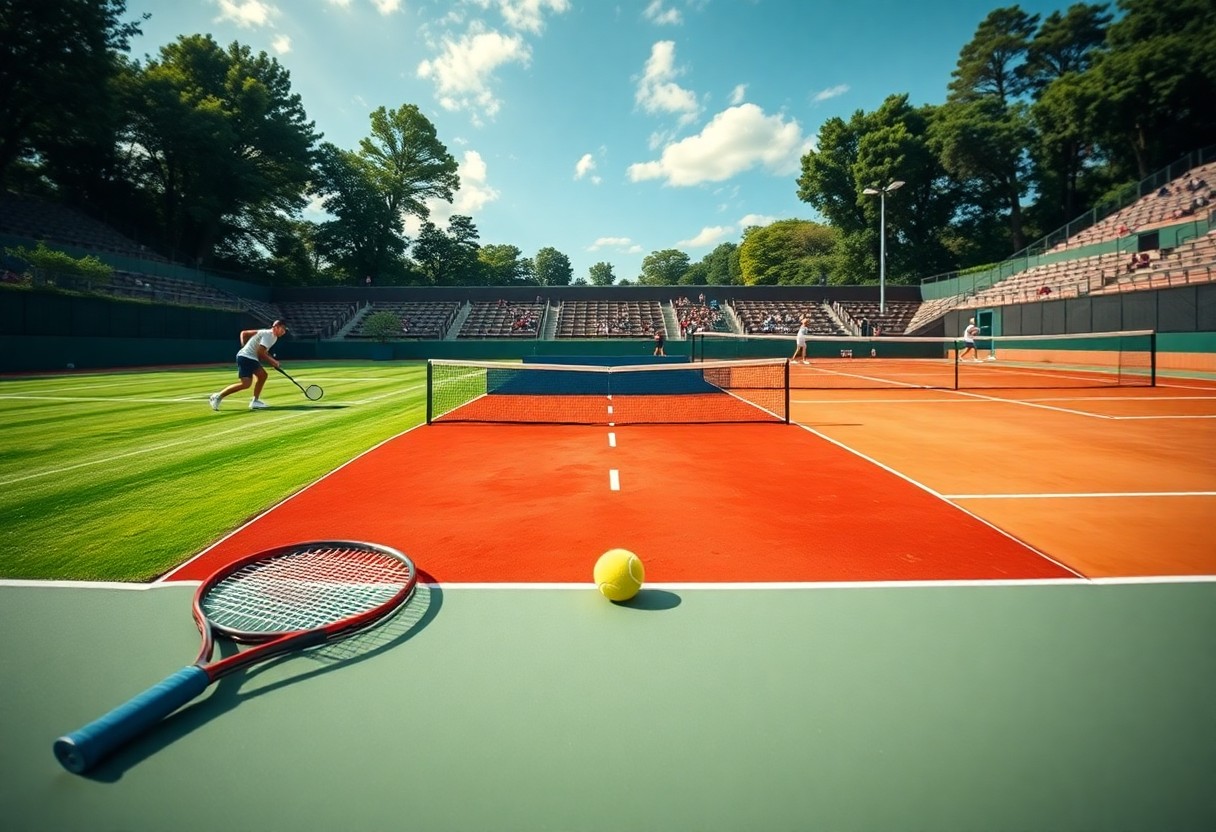Just as a chess master controls the board, your court positioning in tennis can determine the outcome of every point. When you master strategic positioning, you gain the power to dictate play and force your opponent into uncomfortable situations. Your position on the court directly impacts your shot selection, reaction time, and ability to control the game’s pace. By understanding and implementing effective court positioning, you can reduce your opponent’s scoring opportunities while maximizing your own chances of winning points, making it an necessary element of your tennis strategy.
Decoding Court Geometry: The Tactical Playground
Tennis court geometry creates distinct tactical opportunities based on angles, distances, and spatial relationships. Understanding these geometric principles allows you to exploit court dimensions to your advantage. The baseline stretches 27 feet, while the distance from baseline to net spans 39 feet – these measurements shape every shot selection and positioning choice you make during play.
Analyzing Court Zones and Their Strategic Implications
The tennis court divides naturally into three primary zones: baseline, transition, and net. Each zone offers unique advantages – baseline positioning grants maximum court coverage and defensive stability, the transition area enables rapid switches between offense and defense, while net position provides aggressive angle creation and point-ending opportunities. Your mastery of these zones directly impacts shot selection and tactical options.
Balancing Offense and Defense Through Positioning
Your position on the court telegraphs tactical intent to opponents while determining your available shot options. Moving forward signals attacking play, while positioning deeper behind the baseline indicates defensive readiness. Successful players maintain a neutral ready position roughly 2-3 feet behind the baseline, allowing quick transitions in either direction.
This neutral positioning serves as your tactical foundation, enabling rapid responses to incoming shots. From here, you can step in to attack short balls, retreat to defend deep shots, or move laterally to cover angles. Professional players like Rafael Nadal demonstrate this perfectly, starting from a balanced position then explosively moving to wherever the ball demands. Your ability to read plays and adjust positioning accordingly creates a dynamic presence that keeps opponents guessing.
The Psychological Warfare of Court Positioning
Court positioning serves as a powerful psychological tool in tennis, allowing you to assert dominance and control the mental game. By maintaining aggressive positioning and showing confidence in your court coverage, you can create doubt and uncertainty in your opponent’s mind. Players who master positional psychology often find their opponents making more unforced errors and taking unnecessary risks.
Leveraging Opponent Comfort Zones and Pressure Points
Reading and exploiting your opponent’s preferred court positions gives you a significant tactical advantage. By forcing them out of their comfort zones through strategic positioning and shot selection, you can disrupt their rhythm and confidence. Moving forward aggressively when they’re pushed deep, or staying back when they expect you at the net, creates psychological pressure that often leads to mistakes.
Creating Opportunities Through Misdirection and Surprises
Mixing up your court positioning keeps opponents guessing and prevents them from settling into a rhythm. Unexpected position changes, like suddenly approaching the net after staying back or shifting your return position, can force rushed decisions and create openings for winners.
Advanced players incorporate subtle body language and positioning cues to mislead opponents about their intended shots. By showing one position but quickly transitioning to another, you can create split-second advantages that make the difference in crucial points. Professional players like Roger Federer have mastered this art, often appearing to move in one direction before explosively changing course, leaving opponents flat-footed and out of position.
Elevating Your Game with Strategic Court Placement
Strategic court placement transforms your tennis game from reactive to proactive. By mastering precise positioning, you gain immediate control over 60% of court coverage while expending less energy. Professional players like Rafael Nadal demonstrate this mastery by consistently positioning themselves to maximize their signature shots, allowing them to dictate play rather than chase balls.
The Art of Anticipating Opponent Movements
Reading your opponent’s body language reveals their likely shot selection before they strike. Watch their shoulder rotation, hip position, and front foot placement – these subtle cues telegraph their intentions. Top players correctly anticipate shots 80% of the time by focusing on these physical indicators. Position yourself two steps ahead by moving during their backswing, not after contact.
Positioning for Effective Shot Selection and Execution
Your court position directly influences your available shot options. Maintaining the optimal strike zone – between waist and shoulder height – requires constant micro-adjustments based on incoming ball trajectory. Split-stepping at the right moment gives you explosive first-step speed in any direction.
Advanced players enhance their shot selection by mastering the “recovery X” – moving diagonally back to the court’s center after each shot. This technique, popularized by Roger Federer, ensures you’re ready for 90% of possible returns while conserving up to 30% more energy compared to straight-line recovery. Your positioning should create a seamless flow between defense and offense, allowing quick transitions to exploit any opening in your opponent’s court coverage.
High-Pressuring Your Opponent: The Role of Court Positioning in Match Play
Strategic court positioning allows you to exert constant pressure on your opponent by taking away their time and options. By positioning yourself closer to the baseline during rallies, you can intercept balls earlier and cut off angles before your opponent can recover. This aggressive positioning forces them to rush their shots and make decisions under duress, leading to more unforced errors and shorter points in your favor.
Using Court Position to Dictate the Pace and Flow of the Game
Your court position directly influences rally tempo and match rhythm. Moving inside the baseline lets you take the ball on the rise, reducing your opponent’s preparation time and forcing them to play at your preferred pace. By alternating between aggressive and neutral positions, you can suddenly change gears – speeding up or slowing down play to disrupt your opponent’s timing and comfort zone.
Controlling Angles: Turning Defense into Offense
Reading your opponent’s position helps you spot opportunities to turn defensive situations into attacking chances. When pushed wide, your court positioning determines whether you can redirect the ball down the line or hit an aggressive cross-court shot. Strategic positioning near the singles sidelines enables you to cover more court while maintaining offensive options.
The geometry of the court becomes your ally when you master positional play. From a defensive position behind the baseline, you can gradually work your way forward by using deep cross-court shots that pull your opponent wide. This creates space for you to approach the net or hit into the open court. Your recovery position after each shot should anticipate your opponent’s most likely replies, allowing you to transition smoothly between defense and offense.
Real-Time Adjustments: Adapting Court Positioning During Play
Reading your opponent’s patterns and adjusting your court position accordingly can make the difference between winning and losing tight matches. Your position should evolve based on your opponent’s tendencies, fatigue levels, and changing weather conditions. Moving forward when you spot signs of their backhand breaking down, or adjusting your depth when wind picks up requires split-second decision-making backed by experience.
Recognizing Key Moments for Tactical Shifts
Match momentum often hinges on identifying precise moments to alter your positioning strategy. Watch for tells like your opponent’s shortened backswing, decreased court coverage, or preference for specific shot patterns. If they consistently hit short when pulled wide, adjust your starting position closer to the net. These tactical shifts can disrupt their rhythm and create immediate scoring opportunities.
Learning from Match Dynamics to Improve Future Strategies
Each match provides valuable data about positioning effectiveness against different playing styles. Track which court positions worked best against baseline players versus aggressive net-rushers. Document scenarios where your positioning choices led to winners or forced errors, creating a personal playbook for future matches.
Building this strategic database requires systematic analysis of your matches. Record specific court positions that proved successful in different situations – serving positions that earned free points, return positions that neutralized big servers, and mid-point adjustments that created winners. Professional players often maintain detailed notes about positioning strategies against regular opponents, allowing them to start each match with tested tactical approaches. Your match observations become particularly valuable when facing similar playing styles in future tournaments.
To wrap up
Considering all points, your court positioning serves as the foundation for executing effective tennis strategies. By maintaining optimal positioning, you can control the pace of the game, minimize your opponent’s opportunities, and maximize your own scoring potential. When you master the art of court positioning, you’ll find yourself spending less energy while achieving better results. Your ability to read the game and position yourself accordingly will elevate your performance across all aspects of play, from defensive maneuvers to aggressive shot-making, making you a more formidable player on the court.




